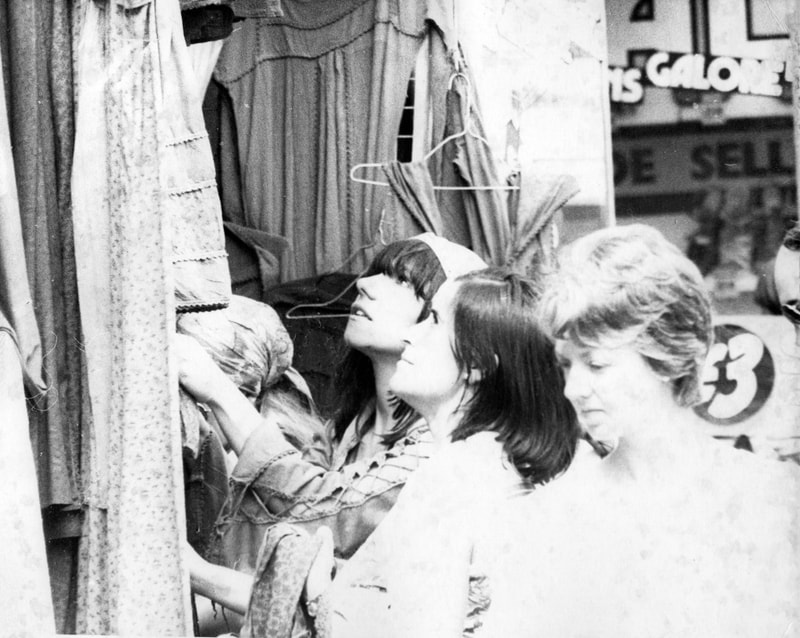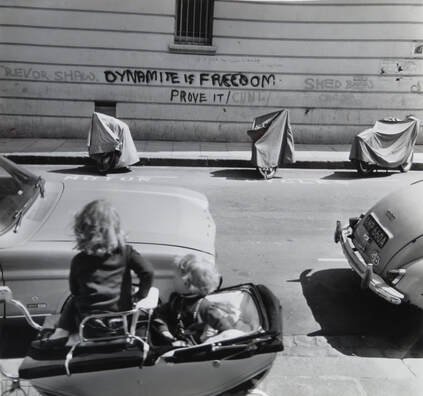Why The Fool? The World is a strange and foolish place. The Fool knows that what is seen as wise at one time can be seen as foolish at another.
The Fool throughout history comes to be seen as a beholder of wisdom.
The Fool throughout history comes to be seen as a beholder of wisdom.
Home
The Fool a designer women’s hippie fashion company started in 1973 with a little bit of magic. The Fool caught the zeitgeist, the spirit of the time.
Can we ever convey a time that is other than the one we live in? We barely register the changes from year to year, as like a wave rippling on to a shore the currents change imperceptibly. Our yardstick of what we think of as good or bad, acceptable or unacceptable change. Trying to express it, however, allows us to see where we are today and where we have come from, without judgment but simply to pay attention to how our thinking and worldview has changed without us noticing it.
cPhotos of some of The Fools, Ruti, Myrna and Aury
The Fool designed manufactured and sold colourful, flowing, lacy 'hippie' style women’s clothes around The Portobello Road area and later on around the UK and Europe at a time of great change. From Aden, Manchester, Eritrea, Cheetham Hill, Scotland, Clydebank, Dvinsk, Russia, Ruti, Myrna and Aury set up The Fool. They viewed their huge cultural differences as an asset and made use of their different life experiences , different expectations to make the project of The Fool work. This hotchpotch combination made the magic happen brought the spark alive and created a successful entrepreneurial business. (hippie - a person of unconventional appearance, typically having long hair, associated with a subculture involving a rejection of conventional values)
|
|
Mary Quant and Biba were the fashion icons of their day. The Fool operated in a different way.They set up from a back street run down workshop, shop with an incredibly low rent in Shrewsbury Road a street off Westbourne Park Road, West London from where the 3 of them all lived with their children.The way they lived and worked was different from many others of their generation. Many of their peers had a conventional life style, a job, a family, a house and possibly a weeks UK holiday a year. Myrna Ruti and Aury broke away from the expected behaviour from their family background. This allowed them to be open to different ways of seeing and doing . See History
|
They sold retail and wholesale from Shrewsbury Road and from a stall on a Saturday in Portobello Road market and on Saturday and Sundays in Camden Lock market.
Liliane 1970s and 2010 did some of the fabric cutting with an industrial machine. Here she wears Fool and Trivia clothes.
Where had the idea for The Fool a fashion enterprise come from? Ruti, Myrna and Aury had been working for Trivia an indoor market kind of shop in Middlesex Street near Petticoat Lane market, London. It was the beginning of indoor markets, a bit like Kensington market. Aury's brother Morris and Ruti's uncle Judah ran it. "There was someone selling records. Aury sold jewellery, candles and pottery, another person sold shoes and I sold fabrics which African customers loved. Morris, Aury's brother at the beginning sold clothes he bought from wholesalers", Judah. Then, a fashion designer friend from the Royal College of Art, Marissa Martin briefly designed for Trivia. Ruti and Myrna took over the designing and manufacturing. Sometime later Ruti, Myrna and Aury left Trivia needing the freedom to set up their own creative enterprise, The Fool. There was a renewed energy and after a feature in The Drapers Record a wholesale magazine new customer discovered them and ex Trivia customers came and bought from The Fool.
The Fool Eureka Moments A limitation becomes an asset
Hand Dyeing "We had so little money we couldn't afford to buy expensive fabrics to make the clothes. We would go to the East End of London, buying fabric, cheapest possible. We had a eureka moment when we bought pure cotton fabric with a printed pattern on it, often in colours or patterns we didn’t like. We started to experiment with hand dyeing the finished items which were made from a combination of printed fabric and lace inserts. Over dyeing produced something that became typical of The Fool designs creating a gradation of tone and colour and softening the printed patterns.
Ruti & Myrna
Hand Dyeing "We had so little money we couldn't afford to buy expensive fabrics to make the clothes. We would go to the East End of London, buying fabric, cheapest possible. We had a eureka moment when we bought pure cotton fabric with a printed pattern on it, often in colours or patterns we didn’t like. We started to experiment with hand dyeing the finished items which were made from a combination of printed fabric and lace inserts. Over dyeing produced something that became typical of The Fool designs creating a gradation of tone and colour and softening the printed patterns.
Ruti & Myrna
Hitchhiking to find new shops "We couldn’t afford to pay for a train or bus ticket to go wholesaling so at the beginning we had to hitchhike around the country wearing some of the styles carrying a bag of samples searching for shops that we thought likely to sell our hippie style of clothes. Without fail the shop keepers ordered and to our delight found that the clothes were so popular that they flew off the rails and re orders came in rapidly", Myrna & Ruti. Remember - There were no mobile phones or internet to search for this information at that time. Later on shopkeepers came and bought from our shop.
Publicity "We had no money, couldn’t afford to put an advert in a magazine. So I called newspapers and magazines and told the fashion editors what we did, hoping to get copy. What I learnt is that people tell you what they want to hear for example, I would be asked do you use lace, which we did. Then I would emphasise the lace in our designs. Our designs were based on medieval costumes designs or costumes from other eras or continents, using simple shapes circles, squares, triangles or rectangles and we had a whole spread in Vogue, The Guardian, Time Out and The Daily Mail. They did a feature on us which didn’t cost us anything. They came and photographed us in Shrewsbury Road" .Myrna
Wholesaling
Myrna - I simply telephoned the editor of Drapers Record, a trade magazine and spoke about what we did. They were happy to write about The Fool. I managed to get them to do an article about us and wholesale customers discovered us and came to buy, genuinely excited and intrigued by it all.
Myrna - I simply telephoned the editor of Drapers Record, a trade magazine and spoke about what we did. They were happy to write about The Fool. I managed to get them to do an article about us and wholesale customers discovered us and came to buy, genuinely excited and intrigued by it all.
The Fool "became successful as we were able to survive, doing our own thing through our fearlessness and creativity. Myrna and I discovered festivals where we would sell our clothes, setting up a stall and living rough in a tent for a few days. Despite all this improved business our living conditions in Shrewsbury Road didn't improve. We lived in a factory, really. We had people working with us from Bangladesh, people from Africa, The Caribbean, Irish, Japanese. We even had some nuns working with us. The nuns wore a simple habit but they had to be in the world. So they worked for us. We had a great education," Ruti
|
The Westbourne Park Road Portobello Road area around The Fool was poor in the 1970s. It was very working class then, similar to the East End of London, like Call the Midwife.
Rag and bone men in their horse drawn carts wandered around the streets. In a way this area was the the end of a Victorian, Edwardian era with such poverty that people wouldn’t believe today. see Living in the area "In and around Portobello, there were lots of hippy-type characters living around the area; a lot of people squatting. We lived on so little, but there were people living off the street as we were. People were throwing stuff out chairs, sofas, mirrors, beds for example. We were genuinely recycling. We furnished our accommodation at Westbourne Park Road and Shrewsbury Road with stuff we found thrown out on the street," Ruti and Myrna |
We lived on very little money. There was barely any heating in the building rented by The Fool. There were a few paraffin heaters or a single bar electric heater. The machinists had a one bar electric heater to warm their work area. It was so cold living at The Fool that Ruti, Myrna and Aury lived and worked with their outdoor coats on all day long. Back in the 1970s most heat in homes was lost up the chimney because of open coal fires or uninsulated walls and roofs. Not many people had central heating.
Our house would not be seen as fit to live in by today’s standards. We had around 12 wild cats living in our basement, which was still owned my our landlord. My parents had both just left the Royal College of Art a few years before. As a baby I was bathed in a metal tub on our kitchen table. I remember putting the jelly on the window sill to set as we had no fridge. We slept on a mezzanine bed on an old mattresses, which had insects living in them. I remember a string of fascinating and bohemian people living with us at Westbourne Park Road, Raghav Kaneria the sculptor from Gujarat, India, Zvia Sadja and Ruti. Nahem
"We never noticed how poor our surroundings were. We put up with being permanently freezing cold in winter as we knew no different. I can't remember any of the places we visited having central heating at that time" - Myrna
There were different smells during that time. In the 1960s and even into the 1970s and 1980s smoking was permitted nearly everywhere: smokers could light up at work, in hospitals, in school buildings, in pubs, in restaurants, in cinemas, theatres, on television, and even on buses, trains and planes. Smoking was integral to every day life. Un-emptied ashtrays were all over the place at The Fool. Many of the workers as well as Aury smoked heavily. Myrna as one of the non smokers had no choice but to put up with it. Smoking was the norm.
The Fool was a female powerhouse..... the ideas, the inspiration, the innovation, the sheer hard graft, the humour, the bonds of friendship..... all women. A unique and joyous experience for me at least - Liza
The Fool Wisdom Myrna and Ruti worked 24 / 7 going down to the workshop any time of the day or night or weekends excited with an idea they wanted to try out. They learnt that to make a successful entrepreneurial business you have to put full energy into it. If they had worked 9-to-5 hours they would never have got the project off its feet.
|
A Childhood Remembered - Sandra and Myrna's Stories of a time, Past, Present and Future
|
Myrna Shoa's projects art website - Take a look at Myrna's art, community projects and published stories
|













